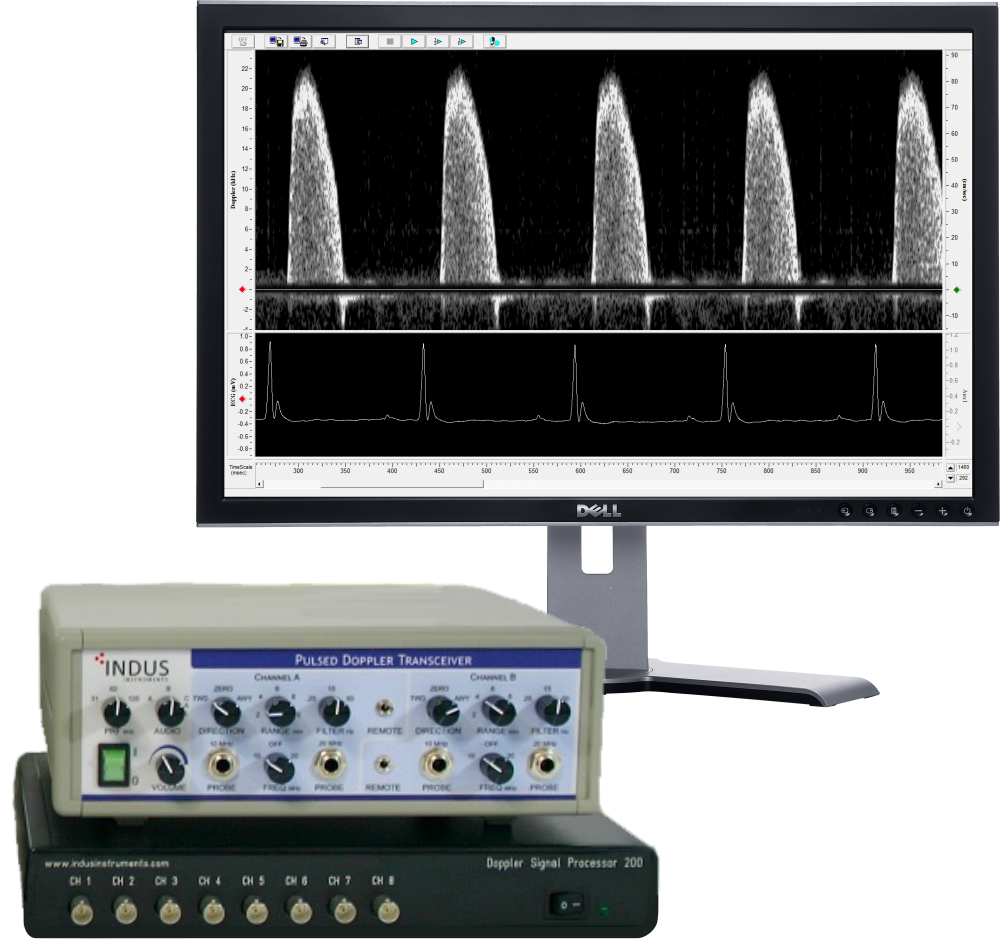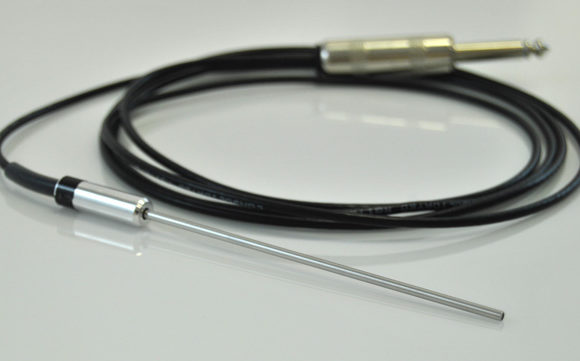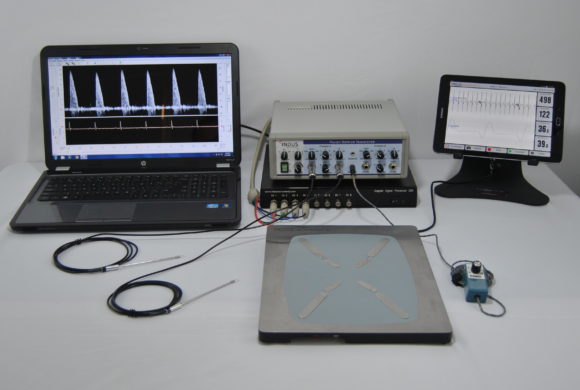Doppler Flow Velocity System
The Indus Doppler Flow Velocity system is used to noninvasively evaluate cardiovascular physiology and function primarily in anesthetized mice and rats. Investigators can serially follow changes that occur due to aging, disease progression, remodeling and the effects of surgical or pharmacological interventions.
The system consists of four components: Pulsed Doppler Transceiver, Doppler Signal Digitizer, Doppler Workstation and Handheld Probe.
System Overview

The Indus Doppler Flow Velocity System is a high-frequency, real-time pulsed Doppler measurement device with integrated data analysis software designed for measuring cardiovascular function in small animals. The high sampling rates grant excellent temporal resolution, making this the ideal system for studying fast heart rates and rapid blood accelerations present in small animals. Hardware components include the Pulsed Doppler Transceiver (PDT), a 10 & 20 MHz switchable dual channel system, Doppler Signal Digitizer (DSD) and Doppler Workstation (DW).
Pulsed Doppler signals from the PDT are digitized at high sampling rates by the DSD and the workstation software. The acquired signals are processed using a fast Fourier transform algorithm and displayed as real-time grayscale Doppler flow velocity spectrograms. The workstation software permits recording and analysis of these spectrograms, ideal for report generation and publication purposes. This system has been successfully used in publications with mice, rats, bats, naked mole rats and other small animals. It is also capable of measuring blood flow velocities in larger animals using our implanted extra-vascular Doppler cuff probes.
Handheld Transducer
For most applications, a noninvasive rigid probe with an end-mounted transducer is required. The active element is a 1.0 mm diameter (10 or 20 MHz) piezoelectric crystal recess-mounted at the end of the probe using epoxy molded into a lens to focus the sound beam.
This type of focused probe has been applied in mice and rats to measure cardiac and arterial blood velocity noninvasively. The probe can be held with a steady hand, or mounted in a micromanipulator which often assists with measurement accuracy and consistency.

Silicone Cuff Transducers
For chronic (implanted), extra-vascular applications or when the vessel cannot be accessed by a probe, a cuff transducer can be used. The cuff body is molded of flexible silicone and split lengthwise so that it can be slipped around the vessel. The piezoelectric crystal (10 or 20 MHz) is 1.0 mm diameter and mounted at a 45-degree angle using medical-grade epoxy.
Parameters Measured
| Surgical Monitoring & Vital Sign Measurements | |
|---|---|
| Heart Rate | |
| R-R Interval |
| Systolic Indices: Aortic Outflow Velocity | |
|---|---|
| Peak velocity | |
| Mean velocity | |
| Peak acceleration | |
| Mean acceleration | |
| Pre-ejection time | |
| Ejection & Rise time | |
| Stroke distance |
| Diastolic: Mitral Inflow Velocity | |
|---|---|
| E-peak & E-stroke velocity | |
| E-time duration | |
| E-acceleration & E-deceleration time | |
| E-peak to ½ E-peak time | |
| E-linear deceleration time & rate | |
| A-stroke distance | |
| A-time duration | |
| E-A peak velocity ratio | |
| Isovolumic contraction time | |
| Isovolumic relaxation time |
| Peripheral Artery: Carotid, Renal, Femoral & Tail | |
|---|---|
| Peak Velocity | |
| Mean & Minimum flow velocity | |
| Pulsatility Index | |
| Resistivity Index |
| Other: Coronary, Transverse & Abdominal Aorta | |
|---|---|
| Peak Diastolic Velocity (Coronary) | |
| Peak Systolic Velocity (Coronary) | |
| Diastolic & Systolic Area (Coronary) | |
| Ratios PSV/PDV & SA/DA | |
| Pulse Wave Velocity |
Noninvasive Method
using a miniature handheld probe, flow velocities and differentials in various arteries, including the aorta, are reliably measured by placing the tip of the probe at a sharp angle relative to the direction of flow to be measured
Small Footprint
a powerful system that is both compact and easily transportable, allowing it to be scaled in larger facilities with ease or shared between cooperating labs without complication
Translational Data
large bodies of literature support the translational relevance of rodent flow velocity data to clinical findings: study areas include cardiac function, myocardial perfusion, pressure overload, arterial stiffness and more
Valuable measurements done with ease…
Serial measurements or measures responsive to interventions can be made
Cardiac systolic and diastolic function can be assessed under various conditions
Severity of transverse aortic constriction (TAC) can be assessed by comparing left and right carotid velocities
Hyperemic velocity responses can be evaluated by coronary flow reserve, a variable affected by disease, age, and PV overload
Pressure gradient across TAC can be estimated using stenotic jet velocity
Coronary flow distributions can be assessed using systolic / diastolic flow ratio
Induced responses in microvascular beds can be measured through pulsatile and resistive indices
Banding effectiveness and coronary reserve can be measured with Baseline / Hyperemic velocity relations
Hardware Specifications
| Channels | Two, each switchable between 10MHz & 20MHz |
| Power | 110 VAC / 60Hz OR 220 VAC / 50Hz |
| Recorder Outputs | 2 from each channel (Phasic & Mean) |
| Audio Outputs | 2 from each channel (InPhase & Quadrature) |
| Audio Monitor | Amplifier & speaker selectable from any channel |
| External Ground | Intended for chasis grounding, if required |
| USB, RF/DEMOD | Future use |
| Transmitter Pulse Width | 0.4 μs |
| Receiver Pulse Width | 0.32 μs |
| Variable Range Gate | 1-10 mm (1-13 μs) |
| Velocity Outputs | 0.25 V/kHz simultaneous Phasic & Mean |
| Phasic Output Filter | Phasic (1 pole at 50 Hz), Damped (1 pole at 15 Hz) and Mean (2 poles at 0.25 Hz) |
| Probe Connection | Floating & differential (single-ended, differential) |
| Velocity Range | 1-100 cm/s at 0° angle, 2-200 cm/s at 60° angle |
| Electrical Zero | Front panel switches |
| Controls | Range adjustment, Polarity Switch, Filter |
| Ultrasound Frequency | 10MHz | 20 MHz |
| Pulse Repetition Frequency | 31.25, 62.5, 125 KHz | 62.5, 125 KHz |
| Transmitter Output | 25 Vpp into 50 Ohm | 35 Vpp into 50 Ohm |
| Audio Bandwidth | ≈ 100 Hz to 15 KHz | ≈ 200 Hz to 25 KHz |
| Channels | Channels 1 and 2 = Doppler InPhase & Quadrature Channel 3 = ECG Channels 4 – 8 = Auxiliary inputs |
| Input Range | ±10 V |
| Coupling | AC or DC software selectable |
| Sampling | 125 kHz per channel, 16 bits |
| Low Pass Filter | 10, 20, 30, 40, 50, 60, 70, 80, 90, 100, 110, 120, 130, 140 or 150 kHz (via Hardware) |
| High Pass Filter | 100, 200, 400, 600, 800, 1000, 1500 or 2000 Hz (Second or Fourth order, via Software) |
| Digital Signal Processor | 500MHz Dual Core Processor |
| Data Link to PC | USB 2.0 (480 Mb/s) |
| Power | 100-240 VAC Universal Adapter |

Doppler Flow Velocity System, including Doppler Workstation (left), Pulsed Doppler Transceiver (right top), Doppler Signal Digitizer (right bottom), Probes and Remote Range control. Addition of a Rodent Surgical Monitor provides integrated subject warming and ECG measurement.
The Three Rs of Animal Research
The 3Rs (Replacement, Reduction, and Refinement), introduced in 1959 by William Russell and Rex Burch and discussed more frequently in the past 15 years, serve as guidelines when designing experiments involving animals. The Doppler Flow Velocity System embraces these concepts in its design and everyday use.
By collecting data serially, researchers are able to both gather more data and gain extra control over variability - Reducing the number of animals potentially required used per study.
Refining catheter-based or other invasive measurements by using noninvasive handheld probes decreases unnecessary pain.
Further, the small diameter of these probes allow measurements that would be difficult or impossible with systems with larger footprints.
Learn more about the 3Rs at the following locations:

